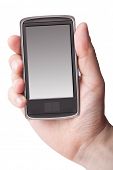By Markham Heid
June 13, 2018
The world is a giant petri dish. You and everything you come into contact with are carpeted with bacteria—so there’s no escaping microorganisms. The good news is that the vast majority of them are either benign or beneficial.
That’s true even of those infamous “fecal bacteria.” While a sick person’s excrement harbors illness-causing germs, a healthy person’s poop—though gross—usually isn’t dangerous. (If you’ve read anything about fecal transplants, you know that the bacteria in feces may in some cases confer health benefits.)
So even if your smartphone is enveloped in an invisible aura of bacteria—and it surely is—most of those bacteria pose no threat to you. “It’s unusual that the general bacteria healthy people leave on surfaces like our phones will make us sick,” says Emily Toth Martin, an assistant professor of epidemiology at the University of Michigan.
That said, germs that can sicken you are out there. And because many of us touch our phones while we eat meals, extra caution is warranted when it comes to these devices.
Illness-causing germs—including the types that cause food poisoning, common colds and other infections—can only make you sick if they enter your body, says Philip Tierno, a clinical professor of microbiology and pathology at New York University’s Langone School of Medicine. They tend to do that by clinging to your hands and then sloughing off onto the foods you put in your mouth, but they can also gain access to your system if you touch your ears, nostrils or breaks in your skin, such as cuts and scrapes. Your phone, too, is a “vehicle that can effectively transfer infectious organisms,” Tierno says.
Assuming you don’t have open wounds on your hands, “it doesn’t matter how dirty they become if you wash them well with soap and water before you eat,” Tierno says. But if, after washing, you pick up a germ-ridden phone—the same one you consulted at the grocery store while you were shopping for raw meat—you’re putting yourself in jeopardy.
“The more people touch a surface, the greater the risk of contamination and sickness if you touch that surface too,” Tierno says. Grab a greasy subway pole and then handle your phone, and your device is going to be smeared with whatever germs your hands just picked up from previous passengers.
So how often should you be cleaning your phone? That depends on where you’ve been and how you handle your device. If you never use your phone while eating, you don’t have to be as diligent about cleaning your device.
But if you tend to use your phone all the time—including during meals—a daily cleanse with a disinfectant wipe is a good idea. “I clean mine twice a day, once in the morning and once in the evening,” Tierno says.
Regularly cleanings may be especially beneficial if you use a rubber phone cover; bacteria tend to more easily cling to that material than to your phone’s metal, glass or hard plastic components, he says. Also, the raised edges where your phone and protective case come together can trap bacteria more effectively than a phone’s smoother surfaces, so those crannies warrant extra attention when you disinfect.
If you’re worried about hurting your device, Apple and other manufacturers recommend turning off your phone before cleaning, and avoiding getting liquid into the device’s charging port or other openings. Also, don’t spray disinfectant directly onto the device. Instead, spritz it onto a clean cloth or paper towel, or use a pre-treated disinfectant wipe. “I’ve been doing this for a long time, and I’ve never damaged my phone,” Tierno says.
If all this seems like a lot of work, there’s a simpler solution: Wash your hands before you eat, and leave your phone in your pocket during meals.

